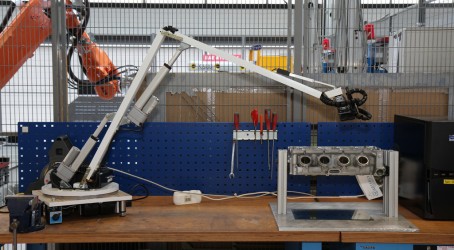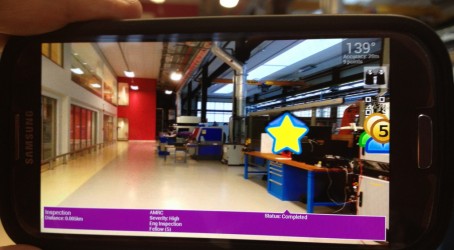Engineering news
IBM and the Advanced Manufacturing Research Centre in Sheffield have developed a robotic camera and information display system to help overcome the challenge of retaining and communicating diminishing amounts of engineering expertise.
The prototype consists of a remote-controlled robotic arm with a camera on the end to provide vision. This is equipped with a laser projector capable of displaying sketches, assembly instructions and CAD images onto either a wall or the parts and equipment being worked on.
The system also uses GPS and smartphones to provide information via augmented reality technology. This overlays points of interest over a plan of the site, such as first aid stations or the location of other engineers. It can also provide other information, such as videos other technicians have recorded from previous visits to the same location.

Dr Rab Scott, head of the Virtual Reality and Modelling Group at the University of Sheffield’s Advanced Manufacturing Research Centre (AMRC), said the inspiration for the prototype came from time spent with technicians in the field. The technicians frequently used the Facetime video app on iPhones to relay information back to a central office, but “were missing two-way communication”.
“The prototype supplies the right information to the right individual at the right moment,” he said.
Scott said as well as improving the efficiency of workforces in the field, one of the main aims of the research project which produced the prototype was to address the challenge of the changing demographic of engineering.
“Within the next 15 to 20 years we are going to lose 60% of our engineers. Many sectors and businesses are facing a cliff edge. So, we were looking at ways to more effectively transfer knowledge between the older generation and the younger generation.”

Richard Lanyon-Hogg, IBM technical director for the industrial sector, said: “This device leverages the skills and experience of those who are heading towards retirement to help the younger technicians in the field. Instead of having your minority of experienced experts zooming around the field, they are at central office helping five or six remotely at the same time, delivering information just in time.
“We used a blend of off-the-shelf components deliberately to show how you can use established technology to overcome these types of challenges,” he added. “But there are many happy years of development remaining in the field of remote working and augmented reality. Companies want to increase the efficiency and effectiveness of their workforces.
"The fusion of IT and advanced manufacturing can achieve this."
Commercial applications of the technology, which could find uses in any sector where remote working is common, such as energy, aerospace, shipping are still “a way away”, admitted Dr Scott. But the Sheffield AMRC is developing the technology further and is discussing with different users about specific requirements, such as a magnetic base for the robotic arm. “We can see this technology developing in a number of different branches,” he added.